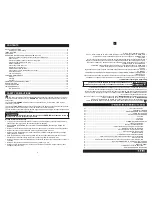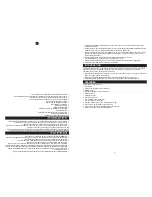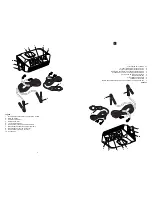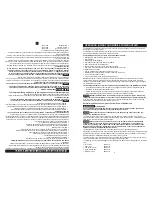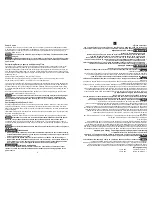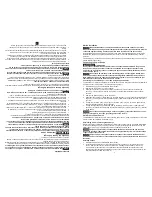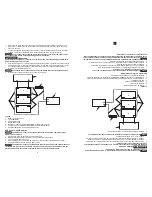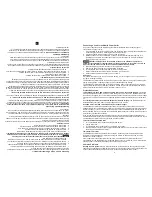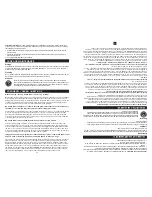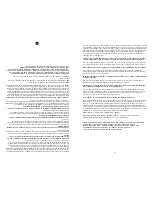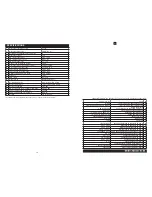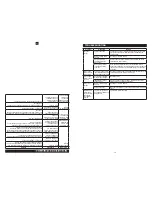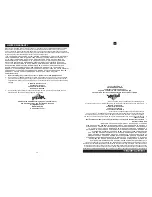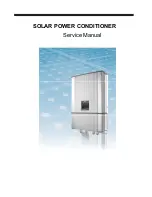
10
Television interference
- The Mobile Power Outlet is shielded and filtered to minimize interference
with TV signals. In some cases, especially with weak TV signals, some interference may be visible. Try
the following corrective measures:
•
Position the Mobile Power Outlet as far away as possible from the television, the antenna and the
antenna cable.
•
Adjust the orientation of the Mobile Power Outlet, the antenna cable and the TV power cable to
minimize interference.
•
Use high-quality, shielded antenna cable.
CARE AND MAINTENANCE
Storage
Store this Mobile Power Outlet in a cool, dry area and keep it away from direct sunlight, heat, excessive
humidity and dampness. Storage temperature should be between -4°F and 185°F (-20°C and 85°C)
with the humidity between 10% and 90%.
Cleaning
Do not clean or wipe the Mobile Power Outlet with solvents or chemical materials. If necessary, remove
dirt or stains using a soft cloth dampened with a mild detergent solution.
Disposal
The Mobile Power Outlet is designed to provide years of service. Because the Mobile
Power Outlet and cables may contain lead, they should be recycled or safely disposed of
at a local recycling center. Examples of places that will accept items like this are: county or
municipal recycling drop-off centers or scrap metal dealers.
FREQUENTLY ASKED QUESTIONS
What issues can cause my mobile power outlet to stop working?
Overheating, incorrect input voltage, and overloading are some basic symptoms. The unit is equipped
with self-protection features that help prevent damage to the mobile power outlet and accessories
being powered by it. There are no replaceable fuses in the mobile power outlet nor do we recommend
or advise opening the unit to repair it. Please follow the proper procedures for resetting the mobile
power outlet which can be found in the owner’s manual for each symptom.
My mobile power outlet does not seem to have the power that I expect from it. Does the age of
the battery or its condition affect the operation of the mobile power outlet?
Yes. Ensure the vehicle battery connections and terminals are free from corrosion and that the battery
is in good working order. If necessary, test the battery to ensure it is producing the proper voltage
level. Clean the terminals with baking soda, water, and a wire brush before connecting the mobile
power outlet to the vehicle battery. Please use all precautions necessary to ensure safety in addition
to wearing rubber gloves and eye protection.
My mobile power outlet is extremely warm during operation. Is this normal?
Under normal operating conditions, the mobile power outlet will be warm but heat should not be
excessive where the case is hot to the touch. If the internal temperature of the mobile power outlet
exceeds its upper limit, the temperature protection feature will engage and the unit will shut off. Allow
the unit to cool, cycle the power switch, and begin using the unit again. Also, do not have the mobile
power outlet in direct sunlight and make sure it is in a well-ventilated area. For adequate performance,
operate the mobile power outlet from 32°F to 104°F (0°C to 40°C).
I plugged a device into my mobile power outlet and it will not power it. The mobile power outlet
began to make a screeching sound and the red LED light is on. What is wrong?
First, test to see if the power source being supplied at the mobile power outlet connection is between
10.5 volts and 14.5 volts (low battery or over-voltage alarm has sounded with red LED light). There
may be adequate voltage coming from the power source but there will be a voltage drop due to the
length and thickness of the wires going to the mobile power outlet connection. If possible, use thicker
gauge wires from the power source to the mobile power outlet or reduce the length of the cables. If
the voltage is not within range, the red FAULT/POWER light will illuminate and the unit will sound an
alarm. The mobile power outlet will have to be reset. Also, it may be necessary to run the vehicle in
order to power the appliance or device upon initial startup and/or during continuous use.
10
Interfer
encia con
la tele
visión
- El Tomacorriente Móvil es blindado y filtr
ado para minimiz
ar la
interfer
encia con las señales de televisión.
En algunos casos, especialmente con señales de tele
visión
débiles, se puede v
er alguna interfer
encia. Tr
ate las siguientes medidas correctiv
as:
•
Coloque el
Tomacorriente Móvil tal lejos como sea posible de la tele
visión, antena y del cable de la
antena.
•
Ajuste la orientación del
Tomacorriente Móvil, del cable de la antena y del cable de ener
gía de la
televisión par
a minimizar la inter
fer
encia.
•
Use cable de antena blindado de alta calidad.
CUIDADOS Y
MANTENIMIENTO
Almacenaje
Almacene este Tomacorriente Móvil de Ener
gía en una área fría y seca, alejado de la luz solar dir
ecta,
el calor y la humedad excesiv
a. La temper
atura de almacenaje debe ser entr
e -4 °F y 185 °F (-20 °C y
85 °C) con una humedad entre el 10% y el 90%.
Limpieza
No limpie o le pase un trapo con disolv
entes o materiales químicos al Tomacorriente Móvil.
Si es
necesario, r
emueva la mugr
e o las manchas con un trapo sua
ve humedecido en una solución de
detergente sua
ve.
Descarte
El Tomacorriente Móvil fue diseñado par
a propor
cionarle años de servicio
. Puesto que el
Tomacorriente Móvil y los cables pueden contener plomo
, ellos deberán ser reciclados o
descartados segur
amente en un centro de r
eciclaje local. Ejemplos de lugar
es que
aceptan artículos como estos son:
centros de r
eciclaje del condado, municipales o
distribuidores de chatarr
a.
PREGUNT
AS FRE
CUENTES
¿Qué prob
lemas podrá causar mi tomacorriente móvil si deja de trabajar?
Recalentamiento, v
oltaje de entrada incorrecto y sobrecarga son algunos de los síntomas básicos
.
La unidad está equipada con un dispositivo de auto protección par
a ayudar a e
vitar daños en el
tomacorriente móvil y en los accesor
ios que están siendo energizados por él. No ha
y fusibles
reemplazables en el tomacorr
iente móvil ni tampoco recomendamos o aconsejamos abrir la unidad
para repar
arla.
Por f
avor siga los procedimientos apropiados par
a reestablecer el tomacorr
iente
móvil, los cuales se encuentran en el man
ual del operador par
a cada síntoma.
Mi tomacorriente móvil no parece tener la energía que esper
o de él. ¿La edad de la batería o
su condición afectan la operación del tomacorriente móvil?
Si. Asegúrese de que las cone
xiones de la batería y los terminales estén libres de corrosión y
que la batería esté en buenas condiciones
. Si es necesar
io, pr
uebe la batería para asegur
arse de
que produce el nivel de v
oltaje apropiado. Limpie los ter
minales con agua de soda, agua y con un
cepillo de alambre antes de conectar el tomacorriente móvil a la batería del v
ehículo. P
or fav
or, use
todas las precauciones necesarias par
a garantizar segur
idad además de usar guantes de caucho y
protección para los ojos
.
Mi tomacorriente móvil se pone extremadamente caliente durante la operación,
¿es esto
normal?
Bajo condiciones de operación nor
males, el tomacorr
iente se calentará pero el calor no deberá ser
excesiv
o al punto de que la caja se ponga demasiado caliente al tacto. Si la temper
atura inter
na del
tomacorriente móvil e
xcede su límite superior
, el dispositivo de protección de temper
atura se activ
ará
y apagará la unidad. Deje que la unidad se enfríe
, cicle el interruptor de energía y comience a usar
la unidad nue
vamente
. T
ambién, no deje el tomacorriente móvil e
xpuesto a la luz solar directa y
asegúrese de que esté en una área bien ventilada.
Par
a obtener un rendimiento adecuado, opere el
tomacorriente móvil entre 32 °F a 104 °F (0 °C a 40 °C).
Enchufé un dispositiv
o en mi tomacorriente móvil y no lo energiza.
El tomacorriente móvil
comenzó a hacer un chillido y la luz LED r
oja se encendió. ¿Qué está mal?
Primero cerciórese de que la fuente de energía que suministr
ada el voltaje a la cone
xión del
tomacorriente móvil esté entre 10,5 v
oltios y 14,5 voltios (la alar
ma de batería baja o de sobre voltaje
ha sonado y la luz LED se puso en rojo). Pueda que ha
ya v
oltaje adecuado proveniente de la fuente
de energía pero habrá una caída de voltaje causada por la longitud y el espesor de los cab
le que van
a la conexión del tomacorr
iente móvil. Si es posib
le, use cab
les de mayor espesor desde la fuente
de energía al tomacorriente móvil o reduzca la longitud de los cab
les. Si el v
oltaje no está dentro del
ámbito, la luz de F
ALLA/ENERGÍA se iluminará y se activará la alar
ma de la unidad. El tomacorr
iente
móvil tendrá que ser reiniciado. T
ambién, pueda que sea necesario oper
ar el vehículo con el fin de
energizar el aparato o dispositiv
o durante la arr
ancada inicial y/o durante el uso contin
uo.


